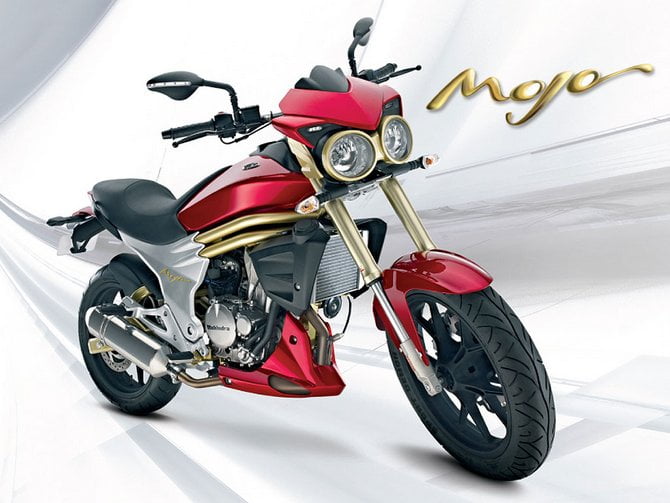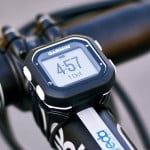In 2015, how should one approach a product, which was first showcased in 2010? Should we consider it as a new product, or a product which is five years old, but is being launched for today’s generation?
That was one of the many questions which was going through our mind when we were on our way to Bengaluru, to test ride the Mahindra Mojo. After riding the bike for 689 kms, on almost all sorts of roads India has to offer, here is what we think of what is going to be Mahindra Two Wheelers’ face for some years to come.
Design
Over the last five years, Mahindra Mojo has gone through a series of design changes. Though the new Mojo keeps basic design cues unchanged, like the twin pod headlamps, twin exhaust, the instrument cluster, rear mono-shock, upside-down front forks, the double golden bars which are part of the twin tube HTR frame. But, there are many changes (including a new logo) which makes the new Mojo look completely different from the old Mojo.

Back in 2010 (image above), what Mahindra showcased was a concept motorcycle, a design study. As Mojo study was a success, the project was given a go-ahead. As compared to that, the new Mojo is a much more masculine, and better looking motorcycle.
Over the last five years, Mahindra improvised Mojo’s design, to offer a riding experience which was not yet offered in the country. Thanks to countless hours of testing, customer inputs, and inputs from experts at Mahindra Racing Team, the team believes they have achieved their objective.

The new Mahindra Mojo is designed as a sport tourer and not as a naked street bike. The scooped seat, raised handle bars, and larger suspension travel are designed to offer the rider a comfortable touring experience.
Design is subjective. If you ask us, at first we thought Mojo’s design to be bit outdated and difficult to digest. But after spending close to 40 hours with the bike, we started to like the design. It is once you start riding Mojo, you understand why is it designed the way it is.
Engine and Exhaust Note

Mahindra Mojo is powered by a 295cc single cylinder liquid cooled 4 stroke engine. This engine is capable of churning out 27 bhp at 8,000 rpm and 30 Nm of peak torque at 5,500 rpm. The engine idles at 1,500 rpm, and comes to life post 2,500 rpm. The initial thrust is not impressive, but the solid mid-range (all the way upto 8,250 rpm) makes up for the lost ground while taking-off.
The clutch is not the easiest and will require at least two fingers to engage. Shifting gears is also a bit notchy when you are shifting at lower rpm’s (about 4,000). But this could be because the bikes were brand new. Usually, after about 2-3k kms of riding, the gearbox gets smoother and shifting gears becomes easier.

Speaking about the exhaust note, Mahindra says that Mojo’s twin exhaust could deliver 8 different beats. After surveying with customers, and internal team, they had decided on the current note. Listen to the Mojo’s note in the video below.
Sounding a bit raw, even the idling note is enough to get you noticed in the crowd. We experienced this. So many people on the road stopped what they were doing, and looked up to see what bike was it.

Gathering a crowd.
Specs, Mileage and Top-speed
2100 mm long, 800 mm wide, and 1165.5 mm tall. Seat height is at 814.5 mm, making it comfortably suitable to ride even for those who are 5.5″ tall. It has a wheelbase of 1465 mm, and a ground clearance of 173.5 mm. Dry weight stands at 165 kgs, which makes it 37 kgs heavier than the Duke 200 and 4 kgs heavier than the Honda CBR 250R. The specially sculpted fuel tank offers a capacity to store 21 litres of fuel, saving on the number of stops you will need to make at fuel stations.
Mahindra did not reveal the mileage, nor the top-speed of Mojo. But during our test ride, we hit the reserve mark after riding the bike for 408 kms. Considering that it has a 3 litre reserve, we were able to extract a mileage of 22.67 kmpl. With normal riding, we expect the bike to deliver a fuel efficiency of more than 30 kmpl in everyday use.

We managed to achieve a speedo indicated 153 kmph. Later that evening, Vinod Sahay, COO, Mahindra Two Wheelers, told us that he has achieved a top speed of 158 kmph on the Mojo!
Another cool feature on board the Mahindra Mojo is the top speed logger. Every time you post a new top speed, the bikes Instrument panel logs the speed into its memory, and it can only be replaced when it is bettered with an even higher top speed. Other features of the instrument panel of the Mahindra Mojo can be seen below:

Offered in a choice of three colours, Black, Red and White, Mahindra Mojo comes with the largest front discs in the segment. It gets a 320 mm single petal disc upfront with radial caliper, while the rear gets a 240 mm petal disc with floating caliper. The braking system is developed in association with Jijuan, a Spanish company which also helps Mahindra Racing Team.
These are fitted onto ten spoke 17 inch alloys finished in black. The wheels are wrapped in upmarket Pirelli Diablo Rosso II rubbers. Front tyre size is 110/70 while the rear gets 150/60 unit.
[“source-rushlane”]





